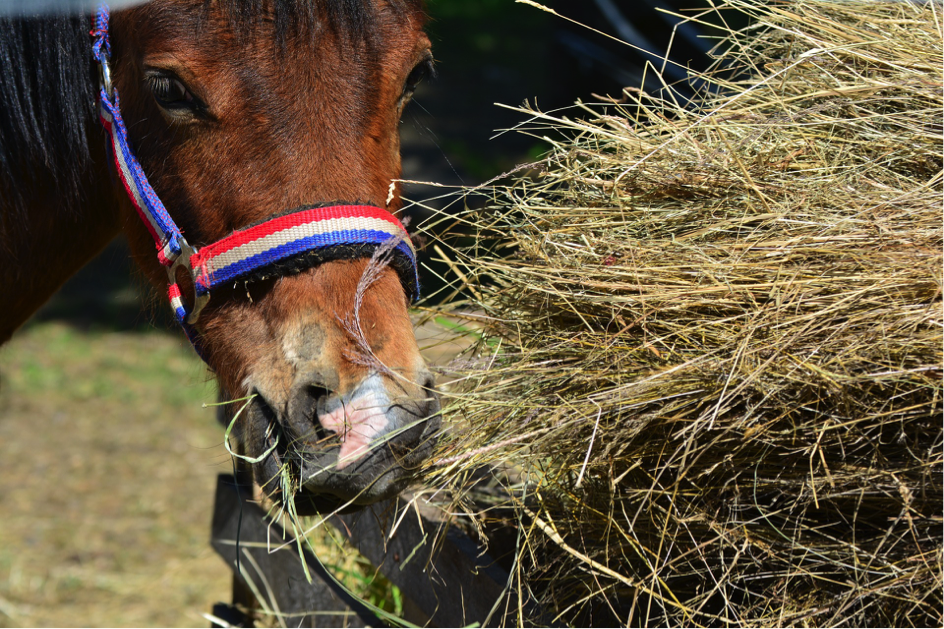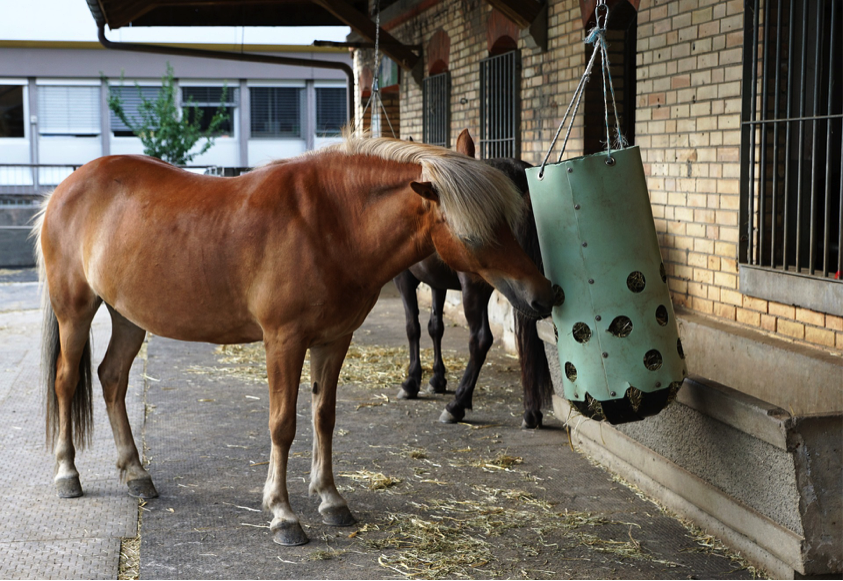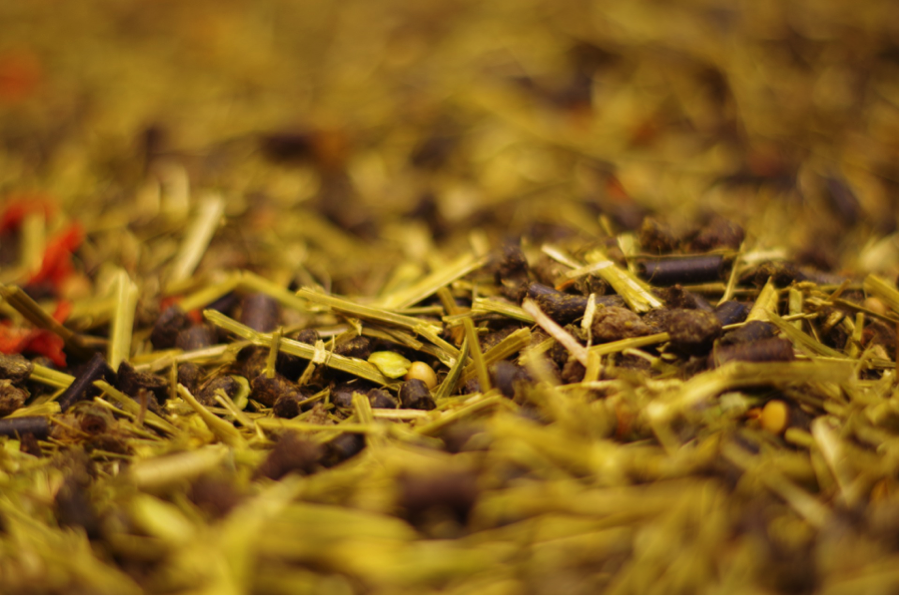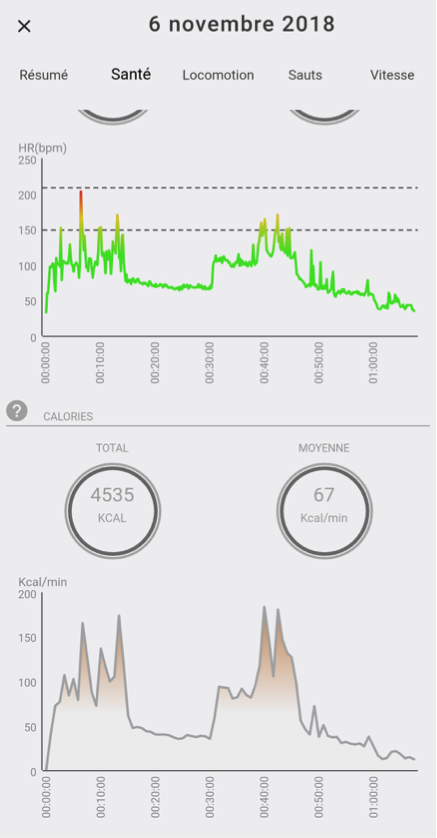jeudi, 15 novembre, 2018
Tout comme les soins, l’alimentation du cheval est essentielle pour son bien-être, son état de santé et ses performances. Une alimentation mal adaptée peut provoquer des coliques ou d’autres maladies digestives. Elle peut également être source quotidienne de mal-être et de stress. Dans cet article, nous abordons le sujet sensible de l’alimentation.

Le cheval est un herbivore monogastrique non-ruminant. Il passe entre 15 et 19 heures par jour à s’alimenter dans la nature. Il se nourrit sous la forme de multiples petits repas, de jour comme de nuit. Contrairement à l’homme, il n’est pas adapté à recevoir des repas en grosse quantité. Son tube digestif est adapté à son mode d’alimentation naturel. Son gros intestin est extrêmement développé alors que son estomac et son intestin grêle sont de petite taille. Il est donc primordial de bien connaître les grandes caractéristiques de la digestion de votre cheval. Il faut aussi comprendre leurs conséquences pour mieux adapter sa ration quotidienne :
– Les juments disposent de 36 dents contre 40 pour les mâles. Ces dernières, à croissance continue, sont adaptées à la consommation de grandes quantités de fourrages, de fibres qui assurent leur usure régulière. Un risque de surdents existe chez le cheval qui ne consomme pas assez de fourrage et qui n’use pas suffisamment ses dents.

Il représente 7% du volume total du tube digestif, soit entre 15 et 18 litres de volume total pour un cheval de selle. Ce dernier est adapté à de petites quantités ingérées à chaque repas, plusieurs fois dans la journée. Le cheval n’est pas un ruminant, il n’avale ses aliments qu’après les avoir soigneusement mâchés et humidifiés grâce à une production abondante de salive. Les parois de son estomac sécrètent de l’acide chlorhydrique (environ 30 litres par jour). Pour neutraliser cet acide, le cheval compte sur sa salive et ce qu’il mange. Sans salive suffisante et sans apport végétal régulier, l’acide attaque la muqueuse. Certaines études montrent que moins de 8 heures suffisent pour provoquer des lésions…
Il représente 30% du volume total du tube digestif. Le temps de séjour des aliments y est court : entre 1 et 2 heures. C’est pourquoi la distribution de petits repas fréquent répartis au cours de la journée améliore l’efficacité de la digestion, notamment pour les aliments concentrés.
Le temps de transit total y est de 24 à 48 heures selon la composition de la ration. Il est plus rapide pour les rations peu fibreuses. Y est digéré par fermentation ce qui ne l’a pas été en amont du tube digestif. Les nombreux micro-organismes présents permettent de dégrader en particulier les fibres. Leur nombre et leur composition dépendent de la ration du cheval.

Par conséquent, pour respecter la digestion de son cheval, il est important de lui distribuer des repas réguliers, à horaires fixes, au minimum fractionné en 3 voire 4 repas par jour, ce qui permet d’assurer une consommation répartie dans la journée et une partie de la nuit. Ceci est notamment important pour les aliments concentrés, particulièrement les céréales, qui apportées en repas trop volumineux, se trouvent poussées dans le gros intestin où leur fermentation est la cause de coliques très douloureuses.
Par ailleurs, un apport de fibres tout au long de la journée, apportant des nutriments consommés plus lentement, répond à son besoin de mastiquer et assure un afflux régulier d’aliments dans son tube digestif. Les changements de régime doivent être progressifs afin que la flore de son gros intestin ait le temps d’évoluer pour être efficace : cette flore se nourrit des aliments mais les rend également digestibles pour le cheval. Une transition alimentaire s’effectue sur quelques jours voire sur quelques semaines. Une transition trop rapide est la cause de diarrhées, de coliques.
À chaque cheval correspond une quantité de nourriture précise, dépendant de son métabolisme et de son activité. Elle varie en fonction de ses besoins et de son état de santé. Plus le cheval travaille, plus la quantité de nourriture est élevée.
Il existe un lien entre l’excès de consommation d’aliments concentrés et l’apparition d’ulcères gastriques. Pour limiter les problèmes gastriques et de comportement anormal, le fourrage doit constituer la base de l’alimentation du cheval. A volonté, les chevaux consomment en moyenne 7 à 15 kg de Matière Sèche (MS).
D’une manière générale, la proportion de fourrage doit être maximale pour les chevaux à faibles besoins comme les étalons hors monte ou les poulinières en début de gestation (80 à 100% de la ration journalière). Elle diminue à mesure que les besoins augmentent pour atteindre 40 voire 30% de la quantité de matière sèche distribuée par jour (chevaux de compétition ou de course).
L’apport à volonté réduit le stress et a un impact positif sur le bien-être et le comportement. De plus, les chevaux consommeraient autant de foin la journée que la nuit. Il est donc opportun de distribuer au minimum deux repas de foin : un le matin et un le soir.

Son alimentation peut ensuite être complétée d’aliments traditionnels comme de l’avoine, de l’orge ou du maïs, d’aliments industriels comme les granulés ou les floconnés et d’éventuels compléments.

Ces aliments ont vocation à couvrir ses besoins en énergie (exprimés en Unités Fourragères Cheval, UFC) en protéines (exprimés en g de MADC, Matières Azotées Digestibles Cheval), en minéraux (macro et oligo-éléments) et en vitamines. Les apports journaliers recommandés tiennent compte des besoins du cheval en fonction de sa situation physiologique : sexe, taille, âge, activité physique…. Néanmoins, l’état corporel et le comportement alimentaire de chacun devront également être pris en considération lors de l’ajustement de la ration.
Retrouvez ci-dessous les besoins journaliers pour un cheval de sang de 500 kg :

Source : INRA 2012
Le calcul d’une ration est assez complexe. Il est préférable de demander conseil à son vétérinaire ou responsable d’écurie sur le dosage et la composition de sa ration car il est vital de ne pas suralimenter sa monture.
Selon l’INRA :
Pour un cheval de 500 kg, pratiquant une activité moyenne, travail de type sport 1 à 2 heures par jour, il faut :
Les apports d’une ration de base théorique sur une journée sont de :
La ration de base apporte un total de 2.2 + 0.8 soit 3 UFC pour environ 7.2 kg de MS.
Avec un aliment complet, il faut donc apporter en 2 ou 3 repas : 7,8 UFC – 3.0 UFC soit 4,8 UFC
Si l’aliment X apporte 0.75 UFC par kilo. Le cheval aura donc besoin de 4.8/0.75 = 6,4 kg de X par jour.
Toutefois, attention car un apport en nourriture trop riche et concentrée peut entrainer des problèmes digestifs : coliques, diarrhée, ulcères de l’estomac, fourbure, carences en éléments nutritifs importants, etc… Le transit et la digestion sont des éléments primordiaux et extrêmement sensibles chez le cheval.
Notons que 60% des chevaux sont sujets à des ulcères gastriques. Plusieurs études ont montré que la fréquence cardiaque du cheval augmente en cas de douleur. Grâce à la sangle Seaver, il est possible de détecter ce genre de problèmes.

Un cardio stable mais supérieur à 50 battements par minute comme ici, sur un cheval entrainé, au repos, calme et non stressé peut en effet indiquer une douleur latente, par exemple un ulcère…
Attention, tout dépendra de votre monture. En effet, certains chevaux comme les poneys type Fjord, Highland, Islandais ont au repos un rythme cardiaque plus élevé que la normale (30-40 bpm). Dans ce cas, ce type de figure peut être alertant seulement si cela se répète (avant séance, cheval immobile et calme dans son lieu de vie).
Travailler son cheval entraîne une augmentation de ses dépenses énergétiques par rapport à une situation de repos, qui résulte d’abord de la mise en mouvement des muscles, mais aussi de l’accroissement de l’activité des appareils respiratoire et cardiovasculaire.
Sur l’écran d’accueil de votre app, il est possible de suivre le nombre de calories brûlées par votre cheval en temps réel. A la fin de l’entraînement, nous donnons également le nombre total de calories brûlées, la dépense énergétique moyenne du cheval en kcal/min, et son évolution sur la séance. Ainsi, en mesurant le nombre de calories brûlées par leur cheval au cours du temps, Seaver vous offre la possibilité d’ajuster si besoin l’alimentation de votre animal préféré.

Pour éviter les déséquilibres d’origines alimentaire voici quelques conseils et règles d’or à respecter :
– Faites attention aux dents de votre cheval, surtout ses molaires qui jouent le rôle d’une véritable râpe. En cas d’obstacle au frottement, il peut y avoir une diminution très importante de la digestibilité des aliments. La qualité de la mastication est très facile à mettre en évidence par l’examen des crottins. Si les grains repassent non digérés, c’est que le cheval ne mâche pas bien.
– Il faut noter que le cheval souffle sur ses aliments, ce qui le rend sensible à la poussière. Il est donc préférable de privilégier une alimentation au sol dans une zone propre (éviter le sable ou la terre) ou à faible hauteur afin de faciliter l’expectoration des poussières inhalées (trachée orientée vers le bas).
– Si votre cheval se montre un peu « glouton », mettez des morceaux de pierre à sel dans la mangeoire pour freiner son appétit. Et, pour ne pas perturber le début de sa digestion, évitez de le faire travailler dans l’heure qui suit la distribution de nourriture.
– Les microbes présents dans son appareil digestif sont très sensibles aux changements de ration car ils sont spécifiques de chaque aliment, c’est pourquoi il faut ménager des transitions alimentaires progressives lors de changement de régime afin de permettre à cette flore microbienne de s’adapter.
– L’usage de litière autre que la paille augmenterait les risques de comportements anormaux. La litière de paille contrairement aux copeaux de bois, favorise davantage la position en décubitus latéral (cheval allongé de tout son long). Surtout, elle amène le cheval à rechercher en continu des aliments limitant l’ennui.
A bientôt pour un nouvel article,
L’équipe Seaver 😘